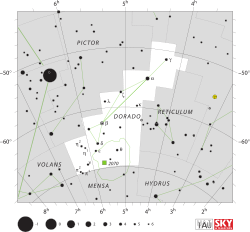Beta Doradus

| |
| Observation data Epoch J2000.0 Equinox J2000.0 (ICRS) | |
|---|---|
| Constellation | Dorado |
| Right ascension | 05h 33m 37.51729s[1] |
| Declination | −62° 29′ 23.3692″[1] |
| Apparent magnitude (V) | 3.63[2] |
| Characteristics | |
| Spectral type | F4-G4Ia-II[3] |
| U−B color index | +0.55[3] |
| B−V color index | +0.70[2] |
| R−I color index | +0.48[2] |
| Variable type | δ Cephei[4] |
| Astrometry | |
| Radial velocity (Rv) | +7.2[5] km/s |
| Proper motion (μ) | RA: +0.79[1] mas/yr Dec.: +12.74[1] mas/yr |
| Parallax (π) | 3.14 ± 0.16[6] mas |
| Distance | 1,040 ± 50 ly (320 ± 20 pc) |
| Absolute magnitude (MV) | −3.91 ± 0.11[7] |
| Details | |
| Mass | 6.5[8] M☉ |
| Radius | 67.8 ± 0.7[9] R☉ |
| Luminosity | 3,200[7] L☉ |
| Surface gravity (log g) | 1.3[10] cgs |
| Temperature | 5,445[7] K |
| Metallicity [Fe/H] | –0.13[10] dex |
| Rotational velocity (v sin i) | 0[3] km/s |
| Other designations | |
| Database references | |
| SIMBAD | data |
Beta Doradus (Beta Dor, β Doradus, β Dor) is the second brightest star in the southern constellation of Dorado.[8] It has an apparent visual magnitude of 3.63,[2] making it visible to the naked eye from the southern hemisphere. Based upon parallax measurements with the Hubble Space Telescope, it is located at a distance of 1,040 light-years (320 parsecs) from Earth.[6]
Beta Doradus is a Cepheid variable that regularly changes magnitude from a low of 4.05 to a high of 3.45 over a period of 9.842 days.[12] The light curve of this magnitude change follows a regular saw-tooth pattern.[13] During each radial pulsation cycle, the radius of the star varies by ±3.9 times the Sun's radius around a mean of 67.8.[9] Its spectral type and luminosity class are likewise variable, from F-type to G-type and from a supergiant to a bright giant.[3]
Far ultraviolet emissions have been detected from this star with the Far Ultraviolet Spectroscopic Explorer, while X-ray emissions were detected with the XMM-Newton space telescope. The X-ray luminosity is about 1 × 1029 ergs/sec and the emission varies with the pulsation period, suggesting a connection with the pulsation process. The peak X-ray emissions are in the 0.6–0.8 keV energy range, which occurs for plasmas with temperatures of 7–10 million K.[13]
References
- ↑ 1.0 1.1 1.2 1.3 van Leeuwen, F. (November 2007), "Validation of the new Hipparcos reduction", Astronomy and Astrophysics 474 (2): 653–664, arXiv:0708.1752, Bibcode:2007A&A...474..653V, doi:10.1051/0004-6361:20078357
- ↑ 2.0 2.1 2.2 2.3 Turner, D. G. (April 1980), "The reddening of Beta Doradus", Journal of the Royal Astronomical Society of Canada 74: 64–69, Bibcode:1980JRASC..74...64T
- ↑ 3.0 3.1 3.2 3.3 HR 1922, database entry, The Bright Star Catalogue, 5th Revised Ed. (Preliminary Version), D. Hoffleit and W. H. Warren, Jr., CDS ID V/50. Accessed on line September 9, 2008.
- ↑ bet Dor, database entry, The combined table of GCVS Vols I-III and NL 67-78 with improved coordinates, General Catalogue of Variable Stars, Sternberg Astronomical Institute, Moscow, Russia. Accessed on line September 9, 2008.
- ↑ Evans, D. S. (June 20–24, 1966), Batten, Alan Henry; Heard, John Frederick, eds., The Revision of the General Catalogue of Radial Velocities, University of Toronto: International Astronomical Union, Bibcode:1967IAUS...30...57E
- ↑ 6.0 6.1 McArthur, Barbara E. et al. (May 2011), "Astrometry with the Hubble Space Telescope: Trigonometric Parallaxes of Selected Hyads", The Astronomical Journal 141 (5): 172, arXiv:1103.2094, Bibcode:2011AJ....141..172M, doi:10.1088/0004-6256/141/5/172
- ↑ 7.0 7.1 7.2 Turner, David G. (April 2010), "The PL calibration for Milky Way Cepheids and its implications for the distance scale", Astrophysics and Space Science 326 (2): 219–231, arXiv:0912.4864, Bibcode:2010Ap&SS.326..219T, doi:10.1007/s10509-009-0258-5
- ↑ 8.0 8.1 Kaler, James B., "Beta Doradus", Stars (University of Illinois), retrieved 2012-01-01
- ↑ 9.0 9.1 Taylor, Melinda M.; Booth, Andrew J. (August 1998), "The bright southern Cepheid beta Doradus: the radial velocity curve, distance and size", Monthly Notices of the Royal Astronomical Society 298 (2): 594–600, Bibcode:1998MNRAS.298..594T, doi:10.1046/j.1365-8711.1998.01670.x
- ↑ 10.0 10.1 Romaniello, M. et al. (September 2008), "The influence of chemical composition on the properties of Cepheid stars. II. The iron content", Astronomy and Astrophysics 488 (2): 731–747, arXiv:0807.1196, Bibcode:2008A&A...488..731R, doi:10.1051/0004-6361:20065661
- ↑ V* bet Dor -- Classical Cepheid (delta Cep type), database entry, SIMBAD. Accessed on line September 9, 2008.
- ↑ Klagyivik, P.; Szabados, L. (September 2009), "Observational studies of Cepheid amplitudes. I. Period-amplitude relationships for Galactic Cepheids and interrelation of amplitudes", Astronomy and Astrophysics 504 (3): 959–972, arXiv:0908.3561, Bibcode:2009A&A...504..959K, doi:10.1051/0004-6361/200811464
- ↑ 13.0 13.1 Engle, Scott G. et al. (May 2009), "The Secret XUV Lives of Cepheids: FUV/X-ray observations of Polaris and β Dor", Future Directions in Ultraviolet Spectroscopy: A Conference Inspired by the Accomplishments of the Far Ultraviolet Spectroscopic Explorer Mission, AIP Conference Proceedings 1135, pp. 192–197, arXiv:0902.3449, Bibcode:2009AIPC.1135..192E, doi:10.1063/1.3154048
| ||||||||||||||||||||||||||||||||||